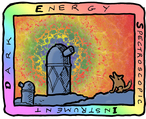| Version 27 (modified by , 9 years ago) (diff) |
|---|
Mosbot
Introduction
Mosbot is a python program that tries to adjust our observing scripts to adapt to changing conditions through the night.
Run it by logging in to the mzls@mayall-idl machine and then running:
cd ~/obsbot python mosbot.py <pass1.json> <pass2.json> <pass3.json>
You will need to keep that window open, because you want mosbot to
keep running all night. pass{1,2,3}.json are the 'plan' or 'JSON'
files that Arjun should have given you; they contain lists of
exposures we want to take depending on what the conditions are doing.
It is probably most convenient to run mosbot from a Terminal window on
the mayall-2 display. You don't need to read any of the output it
produces, but you should check periodically that it is still running;
the code is under development and some bugs remain.
Mosbot Description
Mosbot does two things:
- On startup:
- reads the
pass{1,2,3}.jsonfiles given on the command line - discards exposures that are meant to be taken before the current time
- writes an "overall" script for the night,
~/exec/mosbot/tonight.sh, which runs mini-scripts for each exposure - writes "default" mini scripts for each exposure
- reads the
- Then:
- waits for new images to appear in the
$MOS3_DATAdirectory - when a new image appears:
- measures sky, seeing, and transparency from the image
- decides which pass number to observe in the upcoming exposures
- computes exposure times for the upcoming exposures
- overwrites the mini scripts for these upcoming exposures
- waits for new images to appear in the
The observers run the tonight.sh script on the mosaic3 computer.
Throughout the night, Mosbot overwrites the mini-scripts for upcoming exposures to adapt to the conditions.
How to stop and restart
If you want to stop and restart observing (e.g., to take a focus
sequence), you need to stop both the tonight.sh script, and Mosbot:
- to stop
tonight.sh: On themosaic3computer where you are running thetonight.shscript:touch ~/exec/mosbot/quit
Thetonight.shscript checks for thatquitfile after each exposure, so it can take a while before it actually exits, but you won't lose any data this way. Thetonight.shscript deletes thatquitfile just before it exits, so you don't need to worry about deleting it. - to stop Mosbot, just ctrl-C it.
To start up again,
- FIRST restart mosbot. It will write out a new
tonight.sh - THEN run the new
tonight.shscript
During the night
To Restrict to Pass 2 and/or 3
If, say, the weather has worsened and is highly variable, then you can force Mosbot to always choose a given pass for upcoming exposures by creating files:
touch ~/exec/mosbot/forcepass2
or
touch ~/exec/mosbot/forcepass3
OR, if you want to forbid pass 1, but allow Mosbot to choose between pass 2 or 3, you can create the file:
touch ~/exec/mosbot/nopass1
These files are NOT deleted by the tonight.sh script or by Mosbot,
and will remain in effect until you delete them!
Note that it is Mosbot that pays attention to these files (not
tonight.sh); they affect what it chooses to schedule for upcoming
exposures.
Mosbot command-line options (not usually needed)
- --rawdata=RAWDATA Directory to monitor for new images; $MOS3_DATA by default
- --script=SCRIPTFN Write top-level shell script, default is ~/exec/mosbot/tonight.sh
- --no-write-script
- --ext=EXT Extension to read for computing observing conditions, default im4
- --tiles=TILES Observation status file, default obstatus/mosaic-tiles_obstatus.fits
- --pass=PASSNUM Set default pass number (1/2/3), default 2
- --exptime=EXPTIME Set default exposure time, default is to use whatever exposure time is in the JSON files, usually 80 sec
- --no-cut-past Do not cut tiles that were supposed to be observed in the past
- -h, --help - show this list
Comments
- Mosbot by default starts with PASS 2 observations. And by default, we set all the exposure times to our minimum exposure time of 80 seconds.
- THEREFORE, if you kill mosbot after it has written out the
tonight.shscript and run the defaulttonight.shscript, you will observe pass 2 with short exposures all night long. This is almost certainly not what we want to happen!! - You can change the default pass number with
--pass, and the default exposure time with--exptime. For example, if you are restarting in the middle of the night and you know the conditions are pass 3, you might want to do this. These default exposures are what will run ONLY until the first image is taken and appears on disk. After that, Mosbot will be choosing the pass and exposure time. - The
tonight.shscript is not smart. If you kill and re-starttonight.sh, you will start from the beginning of the night (or the last time Mosbot was run). If you have to stop thetonight.shscript, PLEASE re-run Mosbot to regenerate an appropriatetonight.shscript. - The
tonight.shscript writes to a file~/exec/mosbot/seqnum.txtto indicate which exposure it is currently running. Themosbot.pyscript reads that file to figure out which upcoming exposures it should update. Mosbot by default writes exposures 1 through 10 ahead of the current sequence number. - Each exposure is split into two scripts. For example, exposure 3
happens in
expose-3.sh, which takes the exposure, and thenslewread-4.shslews to exposure number 4 while reading out exposure 3.
About git
- the
~/obsbotdirectory is a git checkout of the repository: https://github.com/legacysurvey/obsbot - There is a "MzLS Observer" GitHub account set up to log in with an
ssh key, so you should be able to
git commitandgit pushany code changes without having to know any passwords.
Pages linking to PublicPages/MayallZbandLegacy/NotesforObservers/MosBot:
